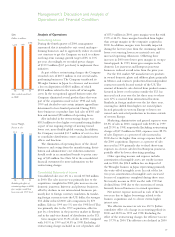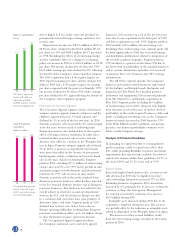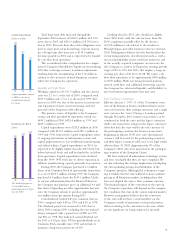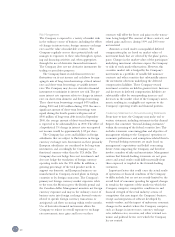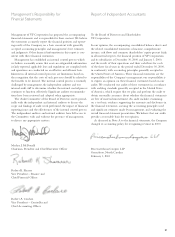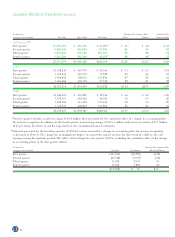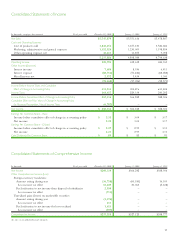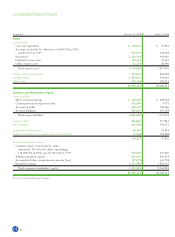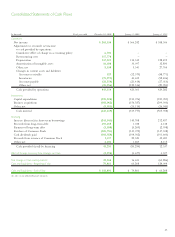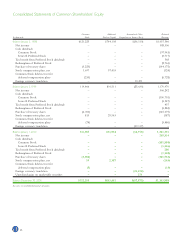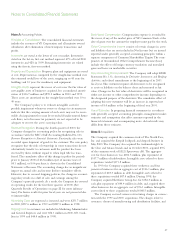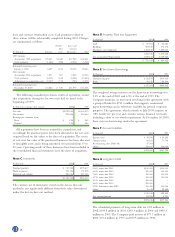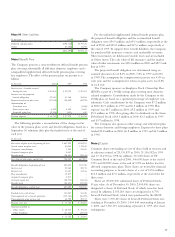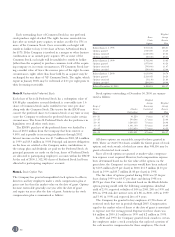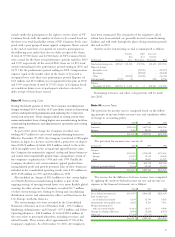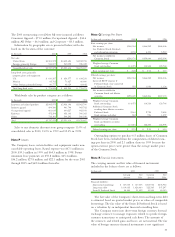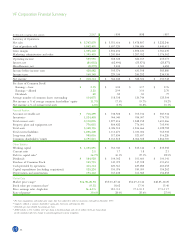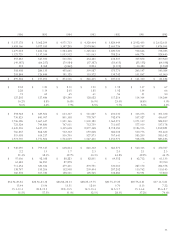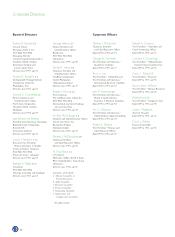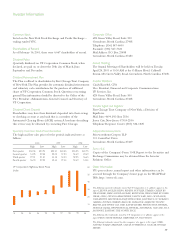North Face 2000 Annual Report Download - page 29
Download and view the complete annual report
Please find page 29 of the 2000 North Face annual report below. You can navigate through the pages in the report by either clicking on the pages listed below, or by using the keyword search tool below to find specific information within the annual report.
27
Stock-based Compensation: Compensation expense is recorded for
the excess, if any, of the market price of VF Common Stock at the
date of grant over the amount the employee must pay for the stock.
Other Comprehensive Income consists of certain changes in assets
and liabilities that are not included in Net Income but are instead
reported under generally accepted accounting principles within a
separate component of Common Shareholders’ Equity. The com-
ponents of Accumulated Other Comprehensive Income (Loss)
include the effects of foreign currency translation and unrealized
gains and losses on marketable securities.
New Accounting Pronouncement: The Company will adopt FASB
Statement No. 133, Accounting for Derivative Instruments and Hedging
Activities, and related amendments at the beginning of its 2001
fiscal year. This statement requires all derivatives to be recognized
as assets or liabilities on the balance sheet and measured at fair
value. Changes in the fair value of derivatives will be recognized in
either net income or other comprehensive income, depending on
the designated purpose of the derivative. The cumulative effect of
adopting this new statement will be an increase in reported net
income of $.4 million at the beginning of fiscal year 2001.
Use of Estimates: In preparing financial statements in accordance
with generally accepted accounting principles, management makes
estimates and assumptions that affect amounts reported in the
financial statements and accompanying notes. Actual results may
differ from those estimates.
Note B Acquisitions
The Company acquired the common stock of The North Face,
Inc. and acquired the Eastpak backpack and daypack business in
May 2000. The Company also acquired the trademark rights to
the Chic and Gitano brands and, in October 2000, acquired 85%
of the common stock of H.I.S. Sportswear AG. The aggregate
cost for these businesses was $206.5 million, plus repayment of
$107.7 million of indebtedness. Intangible assets related to these
acquisitions totaled $171.2 million.
In 1999, the Company acquired three workwear and four
jeanswear businesses for an aggregate cost of $136.1 million, plus
repayment of $23.3 million in debt. Intangible assets related to
these acquisitions totaled $87.4 million. During 1998, the
Company acquired Bestform Group, Inc. for $184.3 million in
cash, plus repayment of $44.4 million in debt, and acquired three
other businesses for an aggregate cost of $76.1 million. Intangible
assets related to these acquisitions totaled $168.5 million.
The Company accrued various restructuring charges in connec-
tion with the 1999 and 2000 acquisitions. The charges relate to
severance, closure of manufacturing and distribution facilities, and
Notes to Consolidated Financial Statements
Note A Accounting Policies
Principles of Consolidation: The consolidated financial statements
include the accounts of VF Corporation and all majority owned
subsidiaries after elimination of intercompany transactions and
profits.
Inventories are stated at the lower of cost or market. Inventories
stated on the last-in, first-out method represent 47% of total 2000
inventories and 42% in 1999. Remaining inventories are valued
using the first-in, first-out method.
Property and Depreciation: Property, plant and equipment are stated
at cost. Depreciation is computed by the straight-line method over
the estimated useful lives of the assets, ranging up to 40 years for
buildings and 10 years for machinery and equipment.
Intangible Assets represent the excess of costs over the fair value of
net tangible assets of businesses acquired, less accumulated amorti-
zation of $306.7 million and $270.5 million in 2000 and 1999.
These assets are amortized on the straight-line method over 10 to
40 years.
The Company’s policy is to evaluate intangible assets for
possible impairment whenever events or changes in circumstances
indicate that the carrying amount of such assets may not be recov-
erable. An impairment loss may be recorded if undiscounted future
cash flows, net of income tax payments, are not expected to be
adequate to recover the assets’ carrying value.
Revenue Recognition: During the fourth quarter of 2000, the
Company changed its accounting policy for recognizing sales in
accordance with the SEC’s Staff Accounting Bulletin No. 101,
Revenue Recognition in Financial Statements. Previously, sales were
recorded upon shipment of goods to the customer. The new policy
recognizes that the risks of ownership in some transactions do not
substantively transfer to customers until the product has been
received by them, without regard to when legal title has trans-
ferred. The cumulative effect of this change in policy for periods
prior to January 2000 of $6.8 million (net of income taxes of
$4.1 million), or $.06 per share, is shown in the Consolidated
Statements of Income. The accounting change has an insignificant
impact on annual sales and income (before cumulative effect).
However, due to seasonal shipping patterns, the change in account-
ing policy results in a shift of sales and earnings among the
Company’s quarterly periods. As a result, the Company has restated
its operating results for the first three quarters of 2000. (See
Quarterly Results of Operations on page 22 for more informa-
tion.) Pro forma results for prior fiscal years are not presented due
to immateriality.
Advertising Costs are expensed as incurred and were $251.7 million
in 2000, $257.6 million in 1999 and $287.5 million in 1998.
Shipping Costs to customers are included in Marketing, Administrative
and General Expenses and were $54.1 million in 2000, $51.0 mil-
lion in 1999 and $44.4 million in 1998.


